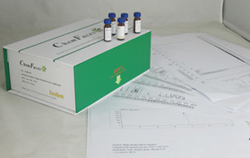Hot Products



| Catalog No. | Information |
| CFN97738 | Rehmannic acid Rehmannic acid and oleanolic acetate inhibit succinoxidase activity. Both Rehmannic acid and Icterogenin are potent uncouplers, abolishing the phosphate uptake, the respiration being inhibited by the former and increased by the latter. |
| CFN90761 | Rehmannioside A Rehmannioside A is an iridoid glucoside. |
| CFN80135 | Rehmannioside C Reference standards. |
| CFN91691 | Rehmapicrogenin Rehmapicrogenin, isolated from the root of Rehmannia glutinosa, exhibits potent anti-inflammatory effect by inhibiting iNOS, COX-2 and IL-6. Rehmapicrogenin attenuates kidney damage by reducing inflammatory factor release through the oestrogen signalling pathway. |
| CFN90760 | Rehmapicroside Reference standards. |
| CFN98829 | Rengynic acid Rengynic acid has potent antiviral effect on RSV for the first time in vitro. |
| CFN98112 | Reserpine Reserpine is an inhibitor of multidrug efflux pumps, used as an antipsychotic and antihypertensive drug. Reserpine ameliorates Abeta toxicity in the Alzheimer's disease model in Caenorhabditis elegans, it can significantly delay paralysis and increase the longevity in this model. |
| CFN91013 | Resibufagin Resibufagin shows strong cytotoxic activity against HeLa cell line. |
| CFN98543 | Resibufogenin Resibufogenin is a cytotoxic steroid isolated from the Chinese drug ChanSu, which exhibits the anti-proliferative effect against cancer cells through the degradation of cyclin D1 caused by the activation of GSK-3β. Resibufogenin can inhibit rectifier potassium current ( I K ) and transient potassium current ( I A ), it has pathological effects on central nervous system. Resibufogenin corrects hypertension in a rat model of human preeclampsia, it not only prevents the advent of hypertension and proteinuria, but also the development of intrauterine growth restriction. |
| CFN70302 | Resokaempferol Resokaempferol inhibits the inflammatory response in activated macrophages by blocking the activation of the JAK2/STAT3 pathway by both LPS and IL-6 signaling. |